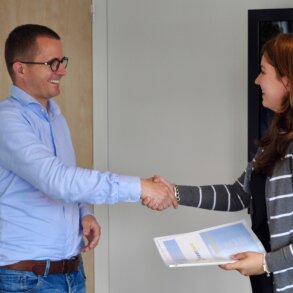By Dávid Pásztor, originally posted here
We never had people managers at UX studio. [2023: Link no longer active.] As creative workers, freedom is very important for us. The biggest fear our team-mates had according to growth is having less impact on the company as an individual. We like hierarchy when we talk about visual hierarchy, but not when we talk about organizations. We always wanted to build an autonomous, self-managing and self-organizing team.
I read the books like Reinventing Organizations. I know Holacracy. Those concepts are cool, but unnecessarily overcomplicated. So instead of hiring an expensive coach we started experimenting ourselves. We solved the problems we had and built up our system from scratch. I’m not saying our method is good for everyone. I’m not saying it’s better than any other systems. But you can probably steal a few good ideas from us. So let me introduce you The Studio Model, a lightweight framework for self-organizing teams.
The 5 key ingredients
These are the five key ingredients for the Studio Model:
- The Process: your minimal workflow and collection of best-practices
- Weekly stand-up: helps the team to organize the short-term operations
- How-we-work meeting: the most important element, a bottom-up method to find and solve problems, utilize opportunities and enhance the system itself
- Retreat: define long-term plans together
- Strategic meeting: follow-up on long-term goals
Let’s discuss them one by one.
The Process
The Process is your workflow written down. It describes the way you work. It doesn’t have to be too specific or too detailed. It is a minimal workflow instead. The steps your team will always follow whatever happens. It can protect you from doing the same mistakes again and again. The Process will be your common ground. The rules everyone knows and follows. You have to create and edit it together.
Putting together your process is very easy. Just sit down with your team and write down how you work, what is the process you want to follow. The result should be a list with bullet-points and key words. Keep it simple. Later you will have enough time to modify and complete it together. It will grow longer in the future or you will add many other guides. But for the first time it should be short. If you need more than an hour to create it, or it is longer than a single page, you are doing something wrong. Think of the Process as a guide to new employees. If they have just ten minutes to read it, will they have enough information to understand how you work?
Weekly stand-ups
The weekly stand-up meeting is for informing about what’s going on, and organizing weekly operations. It’s a little bit different from the sprint meetings software development teams have, as we don’t discuss what to do here. It’s more like a show and tell, with some conversations about timing, coordination and critical points.
We do this on Monday afternoons. We go in a round, and everyone answers the following questions:
- What are you working on? Where are you now in the process?
- What is the biggest challenge you face? Any problems? (The team can give some advice or offer help)
- What is the next step? What is your goal to this week?
- Deadlines? Cooperation with others? (To coordinate how we work together)
- Ideas for topics at the How-we-work meeting (see it later)
- Gossips or fun stories
We have these questions written up on the wall, so when it’s your turn it’s easy to see and answer them.
You will always need someone to lead the meetings, otherwise they will turn into chaos. We go round-robin: someone else is leading the meeting every time. This way the team will feel they have no bossy characters. Everyone will experience what it is like to lead a meeting so they will be more empathetic with others. People will also get better in workshop facilitation. At the end of the meeting we always check who will be the next leader from our list of teammates.
How-we-work meeting
Here comes the good part. As Abraham Lincoln said: “Give me six hours to chop down a tree and I will spend the first four sharpening the axe.”
We stop for an hour every week to sharpen our axes and we call it the how-we-work meeting. This time we discuss topics about how we work together: how to change our processes, how to do certain tasks, or how we solve a problem that came up. Everyone can suggest a topic, we discuss them in smaller groups and make decisions on the spot.
The rules are simple:
- Anyone can suggest a topic. Topics can be work-specific (What tool to use when designing animations?) or about the organization (Change some part of the process. Or do we really need the how-we-work meeting?). We can talk about a problem (We always miss the deadlines.) or an opportunity too (Let’s try Pinterest as a new marketing channel). We collect the topic ideas into an online list accessible to everyone.
- Everyone votes for a topic. In smaller teams (less than 5), the most popular topic wins. In bigger teams you can do more topics parallel in smaller groups.
- Discuss the topics for an hour and come up with solutions together. Let’s make sure you find out a general solution, so the same topic will be solved for a long time.
- The people attending the how-we-work meeting can make any decisions about the topic. They need no permissions from others, and no one can force them to change their minds later. Who wants to have an impact, has to be there.
- If the group is not confident enough they can:
- ask someone else to join (for example someone from finance to discuss the money issues of their plan)
- take a vote for the whole team
- do a pilot with the new method, and come together for a follow-up meeting in a month
- We write a memo of the meeting (the log), and send it to everyone. Change the process document or any other guides if necessary. If we have more discussions simultaneously every group sums up the results to the others at the end.
- Every group choose a change manager who will be responsible to follow-up and make sure the changes will really happen.
As you see the how-we-work is a democratic forum. It gives a place where anyone can come up with ideas and solve problems. The decision making is also distributed. It guarantees that your organization will evolve in small steps week-by-week and everyone can have an impact.
Retreat
We go to a rural place for a long-weekend every six months to discuss our long-term plans and have some fun together. This is the time when you set up goals for the next semester or talk about your values or mission. You can find many good advice about how to do that. In my experience you have to do it in every 6 months. It can boost motivation for everyone.
Strategic meeting
The first how-we-work meeting in every month is different, and we call it strategic meeting. This time the whole team comes together and we follow-up on our long-term goals. We check our KPI’s and collect the todos for the next month. This is also a good occasion to highlight the best achievements we had and celebrate our success. We sometimes just call it the “clapping meeting”, because we show the best designs we created and the team gives a huge applause for the designer.
So that’s it. The weekly stand-up can help in organizing the operations. The how-we-work can solve tensions and grant continuous improvement. The process will be your common ground and guide to work. The retreat and strategic meetings can help with long-term goals. The most important areas are covered. The Studio Model should be enough to run a 5-20 company, and it can be applied to teams in larger organizations too.
I hope it helped. Please give me feedback, or ask questions here: [email protected]
If you don’t want to miss our next post about this topic, you can follow us on Facebook.




